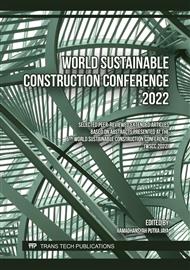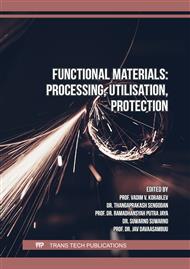[1]
M.A. Hasbullah, R. Yusof, M.N. Yusoff, Assessing the performance of concrete structure based on the width of the crack using UPV, J. Eng. Sci. Technol. 12 (2017) 17-25.
Google Scholar
[2]
S. Widodo, Pramudiyanto, J. Sumiyanto, The study of concrete mixture performance to support the non-destructive testing evaluation, IOP Conf. Ser.: Earth Environ. Sci. 832, 1, (2021) 012018.
DOI: 10.1088/1755-1315/832/1/012018
Google Scholar
[3]
N. Gupta, A. Gupta, Condition assessment of the structural elements of reinforced concrete structure using non-destructive techniques, IOP Conf. Ser.: Mater. Sci. Eng. 116, 1, (2021) 012164.
DOI: 10.1088/1757-899x/1116/1/012164
Google Scholar
[4]
B. Bolborea, C. Baera, S. Dan, A. Gruin, D.D. Burduhos-Nergis, V. Vasile, Concrete compressive strength by means of ultrasonic pulse velocity and moduli of elasticity, Materials. 14, 2, (2021) 7014
DOI: 10.3390/ma14227018
Google Scholar
[5]
A. Ndagi, A.A. Umar, F. Hejazi, M.S. Jaafar, Non-destructive assessment of concrete deterioration by ultrasonic pulse velocity: A review, IOP Conf. Ser.: Earth Environ. Sci. 357, 1, (2019) 012015.
DOI: 10.1088/1755-1315/357/1/012015
Google Scholar
[6]
D. Breysse, Nondestructive evaluation of concrete strength: An historical review and a new perspective by combining NDT methods, Constr. Build. Mater. 33 (2012) 139-163
DOI: 10.1016/j.conbuildmat.2011.12.103
Google Scholar
[7]
C.S.S. Durga, N. Ruben, M.S.R. Chand, C. Venkastesh. Performance studies on rate of self-healing in bio concrete, Mater. Today: Proc. 27 (2020) 158-162
DOI: 10.1016/j.matpr.2019.09.151
Google Scholar
[8]
J.P. Godinho, T.F. De Souza Junior, M.H.F. Medeiros, M.S.A. Silva. Factors influencing ultrasonic pulse velocity in concrete, Ibracon Struc. Mater. J. 13 (2020) 222-247
DOI: 10.1590/S1983-41952020000200004
Google Scholar
[9]
S. Sajjadi, R. Madandoust, Evaluation of self-healing performance of concrete containing fly ash and fibres, Australian J. Struc. Eng. 22, 3, (2021) 177-190. https://doi.org/10.1080/13287982. 2021.1935426
DOI: 10.1080/13287982.2021.1935426
Google Scholar
[10]
J. Xu, W. Yao, Multiscale mechanical quantification of self-healing concrete incorporating non-ureolytic bacteria-based healing agent, Cem. Concr. Res. 64 (2014) 1-10
DOI: 10.1016/j.cemconres.2014.06.003
Google Scholar
[11]
K.Tomczak, J. Jakubowski, L. Kotwica. Key factors determining the self-healing ability of cement-based composites with mineral additives, Materials. 14 (2021) 4211. https://doi.org/
DOI: 10.3390/ma14154211
Google Scholar
[12]
E. Schlagen, N.T. Heide, K.V. Breugel, Crack healing of early age cracks in concrete. In Measuring, monitoring and modeling concrete properties, Springer. (2006) 273-284, Dordrecht.
DOI: 10.1007/978-1-4020-5104-3_32
Google Scholar
[13]
C. Edvardsen. Water permeability and autogenous healing cracks in concrete. ACI Mater. J. 96 (1999) 448-454.
Google Scholar
[14]
M. Luo, C.X. Qian, R.Y. Li, Factors affecting crack repairing capacity if bacteria-based self-healing concrete, Constr. Build. Mater. 87 (2015) 1-7. https://doi.org/10.1016/j.conbuildmat. 2015.03.117
DOI: 10.1016/j.conbuildmat.2015.03.117
Google Scholar
[15]
K.Tomczak, J. Jakubowski, L. Kotwica, Enhanced autogenous self-healing of cement-based composites with mechanically activated fluidized-bed combustion fly ash, Constr. Build. Mater. 300 (2021)
DOI: 10.1016/j.conbuildmat.2021.124028
Google Scholar
[16]
C. Jiang, Y. Yang, Y. Wang, Y. Zhou, C. Ma, Autogenous shrinkage of high performance concrete containing mineral admixtures under different curing temperatures, Constr. Build. Mater. 61 (2014) 260-269
DOI: 10.1016/j.conbuildmat.2014.03.023
Google Scholar
[17]
V. Kanthe, S. Deo, M. Murmu, Effect on autogenous healing in concrete by fly ash and rice husk ash, Iranica J. Energy. Environ. 10, 2 (2019) 154-158
DOI: 10.5829/ijee.2019.10.02.13
Google Scholar
[18]
Y.F. Su, C. Huang, H. Jeong, T. Nantung, J. Olek, P. Baah, N. Lu, Autogenous healing performance of internal curing agent-based self-healing cementitious composite, Cem. Concr. Comps. 114 (2020) 103825
DOI: 10.1016/j.cemconcomp.2020.103825
Google Scholar
[19]
M.S. Rais, R.A. Khan, Experimental investigation on the strength and durability of bacterial self-healing recycled aggregate concrete with mineral admixtures, Constr. Build. Mater. 306 (2021) 124901
DOI: 10.1016/j.conbuildmat.2021.124901
Google Scholar
[20]
R.A.B. Depaa, T.F. Kala, An experimental study on fly ash as self-healing material, Int. J. Appl. Res. 13, 8 (2018), 5920-5925
Google Scholar
[21]
ASTM C618-19, Standard specification for coal fly ash and raw or calcined natural pozzolan for use in concrete (2019).
DOI: 10.1520/c0618-00
Google Scholar
[22]
BS EN 12620, Aggregates for concrete (2013).
Google Scholar
[23]
BS EN12390-3, Testing for hardened concrete – compressive strength of test specimens (2019).
Google Scholar
[24]
P. Termkhajornkit, T. Nawa, Y. Yamashiro, T. Saito, Self-healing ability of fly ash-cement systems, Cem. Concr. Compos. 31, 3, (2009) 195-203. https://doi.org/10.1016/j.cemconcomp.2008. 12.009
DOI: 10.1016/j.cemconcomp.2008.12.009
Google Scholar
[25]
L.A. Camara, M. Wons, C.A. Esteves, R.A. Medeiros-Junior, Monitoring the self-healing of concrete from the ultrasonic pulse velocity, J. Compos. Sci. 3, 16 (2019). https://doi.org/
DOI: 10.3390/jcs3010016
Google Scholar
[26]
BS EN 12504-4 (2004) Testing concrete – determination of ultrasonic pulse velocity.
Google Scholar
[27]
G.L. Golewski, B. Szostak, Application of the C-S-H phase nucleating agents to improve the performance of sustainable concrete composites containing fly ash for use in the precast concrete industry, Mater. 14 (2021) 6514
DOI: 10.3390/ma14216514
Google Scholar
[28]
J. Sun, X. Shen, G. Tan, J.E. Tanner, Compressive strength and hydration characteristics of high-volume fly ash concrete prepared from fly ash, J. Therm. Anal. Calorim. 136 (2019) 565-580
DOI: 10.1007/s10973-018-7578-z
Google Scholar
[29]
T.R. Naik, V.M. Malhotra, J.S. Popovics, The ultrasonic pulse velocity method. Handbook on Nondestructive Testing of Concrete, V. M. Malhotra and N. J. Carino, eds., CRC Press, Boca Raton, FL (2004).
DOI: 10.1201/9781420040050.ch8
Google Scholar
[30]
M.R. Karim, M.F.M. Zain, M. Jamil. F.C. Lai, M.N. Islam, Strength development of mortar and concrete containing fly ash: a review, Int. J. Physical Sci. 16, 17 (2011) 4137-4153.
Google Scholar
[31]
N.P. Kaur, J.K. Shah, S. Majhi, A. Mukherjee, Healing and simultaneous ultrasonic monitoring of cracks in concrete, Mater. Today. Comm. 18 (2019) 87-99. https://doi.org/10.1016/ j.mtcomm.2018.10.022
DOI: 10.1016/j.mtcomm.2018.10.022
Google Scholar



